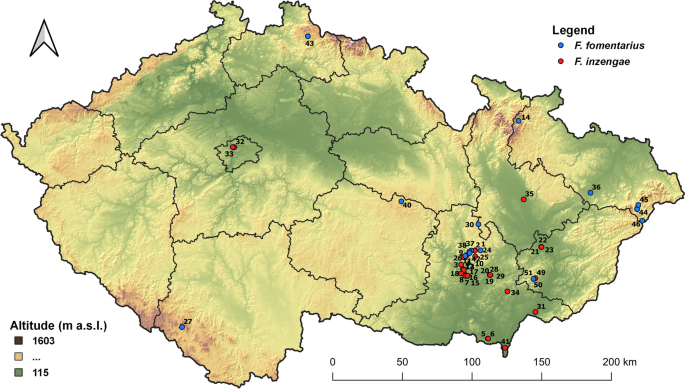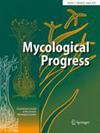Ecological, morphological and phylogenetic survey of Fomes fomentarius and F. inzengae (Agaricomycetes, Polyporaceae) co-occurring in the same geographic area in Central Europe
IF 3
3区 生物学
Q3 MYCOLOGY
引用次数: 0
Abstract
Abstract The phenomenon of cryptic species is widespread among various fungal lineages. Fomes inzengae (Ces. & De Not.) Cooke has been recently recognized as a South European kin of wood-decay basidiomycete F. fomentarius (L.) Fr. due to the problematic morphological identification of both species, their taxonomic status has been disputed. The aim of this research is to examine the distribution, host preferences, morphological characters, and phylogenetic relationships between F. fomentarius and F. inzengae in the South Moravian region in Czechia (Central Europe), where both species occur sympatrically. The results revealed the ecological preferences of Fomes spp. along an altitudinal gradient, while F. inzengae is a lowland taxon, F. fomentarius dominates at higher altitudes in forests with abundant Fagus sylvatica . The main contact zone of the two taxa is located in the upper-colline vegetation belt (elevation ca. 400‒550 m a.s.l.). The morphological analysis revealed that the basidiospore size, the width of skeletal hyphae in basidiomes, and the linear density of pores of both taxa are almost identical and can not be used for the identification of the two species. Multigene sequence analyses of ITS, LSU, RPB1, RPB2, and TEF1 markers confirmed that F. fomentarius and F. inzengae are phylogenetically distinct species. The relationship of F. inzengae and F. fomentarius to Globifomes graveolens and Hexagonia spp. is discussed.

在中欧同一地理区域共生的fomentarius和F. inzengae的生态学、形态学和系统发育调查
摘要隐种现象在各种真菌谱系中普遍存在。真菌(菌类);,不是。)Cooke最近被认为是一种南欧的木腐担子菌F. fomentarius (L.)由于两种植物的形态鉴定存在问题,其分类地位一直存在争议。本研究的目的是研究在捷克(中欧)南摩拉维亚地区,fomentarius和F. inzengae的分布、寄主偏好、形态特征和系统发育关系。结果显示传染媒介的生态偏好种虫害在一个高度的梯度,而f . inzengae低地分类单元,f . fomentarius主导与充裕的Fagus sylvatica在高海拔森林。两个类群的主要接触带位于上缘植被带(海拔400 ~ 550 m)。形态学分析表明,两类群的担子孢子大小、骨架菌丝宽度和气孔线密度几乎相同,不能用于两种植物的鉴别。ITS、LSU、RPB1、RPB2和TEF1标记的多基因序列分析证实,F. fomentarius和F. inzengae在系统发育上是不同的物种。讨论了黄芽孢杆菌和黄芽孢杆菌与黄芽孢杆菌和黄芽孢杆菌的关系。
本文章由计算机程序翻译,如有差异,请以英文原文为准。
求助全文
约1分钟内获得全文
求助全文
来源期刊

Mycological Progress
生物-真菌学
CiteScore
4.50
自引率
8.30%
发文量
94
审稿时长
6-12 weeks
期刊介绍:
Mycological Progress publishes papers on all aspects of fungi, including lichens. While Review Papers are highly welcome, the main focus is on Research Articles on
Taxonomy and Systematics
Evolution
Cell Biology
Ecology
Biotechnology
Pathology (plants, animals, humans)
Manuscripts on current methods applied in, e.g., morphology, anatomy, ultrastructure (TEM, SEM), genetics, molecular biology, chemistry, and physiology will also be considered.
 求助内容:
求助内容: 应助结果提醒方式:
应助结果提醒方式:


